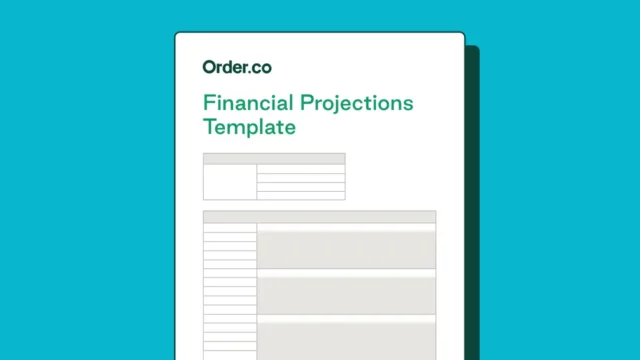Protect Profit with Better Retail Cash Flow Management

Protect Profit with Better Retail Cash Flow Management
Strong cash management makes the difference between getting by and getting ahead.
Retail cash flow management helps you keep the lights on and the shelves stocked without losing sight of funds for future growth. It calls for decisions and practices that help you save sensibly where you can and spend wisely where you must.
This article shares methods for managing the flow of cash through your retail stores. It offers practical ways to control spending, negotiate contracts, and leverage tools to increase savings and improve profitability.
Download the free tool: Financial Projections Template
Why focus on retail cash flow management?
As a retailer, you know it’s necessary to keep enough cash on hand to cover operating expenses and handle unexpected issues. Cash flow is the lifeblood that lets you buy inventory, run your stores, and make payroll. Once you have the basics covered, you can look at growth options like store expansions, new product additions, and business investments.
Building better cash practices helps you maintain positive cash flow, reduce waste, and preserve capital for growth. When you eliminate common cash leaks, you gain more control over how much cash you keep in the bank.
What are the biggest retail cash flow challenges?
Being a successful retail purchasing manager means spending ample time keeping sourcing and spending on track. It requires you to juggle a fast-changing set of business needs and priorities. Lose track of one, and it’s easy for cash flow to dip.
What’s standing in your way? Usually, it comes down to a few familiar obstacles:
- High operating costs: Rising prices and inflation make managing cash flow more difficult, especially when more than 90% of an SMB’s revenue goes toward operational costs.
- Unpredictable trends: Swiftly changing customer expectations can cause overstocks or shortages that drain cash reserves.
- Surprise business expenses: Repairs, missing shipments, and unexpected changes often result in overspending.
- Repayment terms: Inconsistent net terms make cash management harder and increase the risk of late fees.
- Tricky supply chains: Fluctuations in global trade can cause delivery delays and complicate inventory planning.
- Shipping issues: Missing shipments, unreliable carriers, and slow issue resolution can disrupt operations.
- Quality concerns: Product quality issues can impact the customer experience and cut into revenue.
Steps you can take for better liquidity
Good cash flow comes from good systems. When you build policies to guide your buyers, you set them up for success.
These proven steps can help bring down spending and create a more consistent cash flow:
1. Build approvals into the purchasing process
Knowing where your money goes is the first step in managing your bottom line. Adding an approval process makes it easier to keep track of every order and ensure purchases meet your spend policies.
Set up a simple workflow that lets the right approvers—such as department managers, security officers, or the finance team—sign off on spending before it occurs. If your business sometimes buys big-ticket items, consider having a member of the executive team review these purchases as an added layer of control.
2. Control supplies spending
Unexpected expenses can sneak up on you, but supplies shouldn’t be one of them. Once you have approval workflows in place, you start to gain more control over pricing.
You can achieve better cost controls in several ways, such as:
- Setting spending limits for a department or even a certain supply category
- Controlling who makes purchases and how much they can spend
- Putting in parameters for indirect spend to make it less likely that buyers will order out-of-policy supplies
A procurement platform like Order.co makes it easier to set spending guardrails and keep tabs on the cost of supply orders.
3. Negotiate better net terms
Ideally, you want to balance repayments against cash inflows to avoid lopsided schedules that spread your reserves too thin. But managing dozens or hundreds of invoices with different net terms can wreak havoc on your short-term cash planning.
To prevent negative cash flow problems, consider negotiating with suppliers to get a longer repayment window. A higher accounts payable days (DPO) ratio—like 45, 60, or even 90 days—gives you more flexibility to maintain consistent cash reserves. It can also help you take advantage of early payment discounts to reduce the cost of supplies.
Options like buy now, pay later (BNPL) and extended payment terms can also help smooth out spending from month to month. And if you need extra breathing room, a capital advance might provide additional repayment support.
4. Avoid supply over- and understocks
Understocks and overbuying can both negatively impact your cash flow statement. Running out of critical business supplies may force you to pay more for rush orders or substitute items. Buying too much means capital is essentially sitting unused. When you manage stock levels effectively, you help protect the financial health of your small business.
To make the best use of your working capital:
- Audit your supplies and tailor inventory management to avoid overbuying or purchasing redundant items. Reducing the number of SKUs of a certain item (for instance, AA batteries) can help you unlock better pricing, especially if you're ordering for multiple locations.
- Keep larger stocks of the items you use the most. This helps you avoid stockouts and puts you in the best position to negotiate better pricing. It also ensures more consistent product quality and less potential for retail supply chain issues.
Being proactive about your supply levels and volume purchasing helps you get more value out of your buying decisions.
5. Use software to manage buying
Accounts payable and procurement departments at growing companies handle hundreds of transactions every month. This makes managing cash harder over time.
Using a software solution to manage spending and track purchases can save hundreds of hours of manual work. It also helps with vendor selection, increases visibility into purchasing, and automates AP tasks.
How technology supports a better retail cash position
The right tools can make every aspect of running a retail business easier, from choosing the best marketing approach to getting the best supplies. Spend management software helps you manage daily operations by reducing the busywork of accounts payable and finance while giving you more visibility for cash flow forecasting. (One caveat: Your data must enable reliable cash flow forecasting. Some estimates put the cost of unreliable forecasting at $465,000 for a mid-sized company.)
If you’ve been making do with manual cash flow management, consider these benefits of a software-based approach:
- Order management: Procurement platforms track every purchase from sourcing to delivery. A tool like Order.co shows you how much you’re spending with your top vendors, helps you compare prices for goods, and finds replacements when items go out of stock.
- Supplier management: Technology lets you record and track all your supplier info in one place. This helps support vendor management, contract negotiations, and performance tracking for each supplier. Order.co gives you insight into how each vendor fits into your total spending picture.
- Spend visibility: Bringing transactions into a central software system provides a clear view of cash outflows and inflows. That visibility allows you to make better cash management decisions.
- Easy payment processing: Spend management software helps you automate invoices and pay them on time to avoid late fees and capture early payment discounts. Order.co enhances the payment process with features like variable net terms for more efficient scheduling and settlement.
Building healthy cash flow with Order.co
You can manage your cash flow without the complications of spreadsheets and manual tasks. A retail-friendly procurement platform like Order.co helps you spend less on supplies and products while supporting smart planning for growth.
With Order.co, you get the tools you need to control spending and build a path toward future expansion. Our Financial Offerings include capital advances of up to $500,000 with extended net terms, helping you manage cash more effectively without the time-consuming application process characteristic of traditional bank loans.
Retailers rely on Order.co to support long-term growth using:
- A curated catalog of preferred products so you can buy from any vendor and manage it all in one place
- Order management tools that track the progress of every purchase and AI-powered sourcing that recommends replacement items that match your needs
- Sourcing features that help you find the perfect product with options from over 15,000 reliable vendors
- Spend management tools that bring all your purchase data into view so you can make buying decisions and plan budgets based on facts
- Payment features that automate invoice processing and payments, with flexible options like capital advances and variable net terms
See how the right platform and features can help your working capital go further. Schedule a demo of Order.co today.
Get started
Schedule a demo to see how Order.co can simplify buying for your busines
"*" indicates required fields



